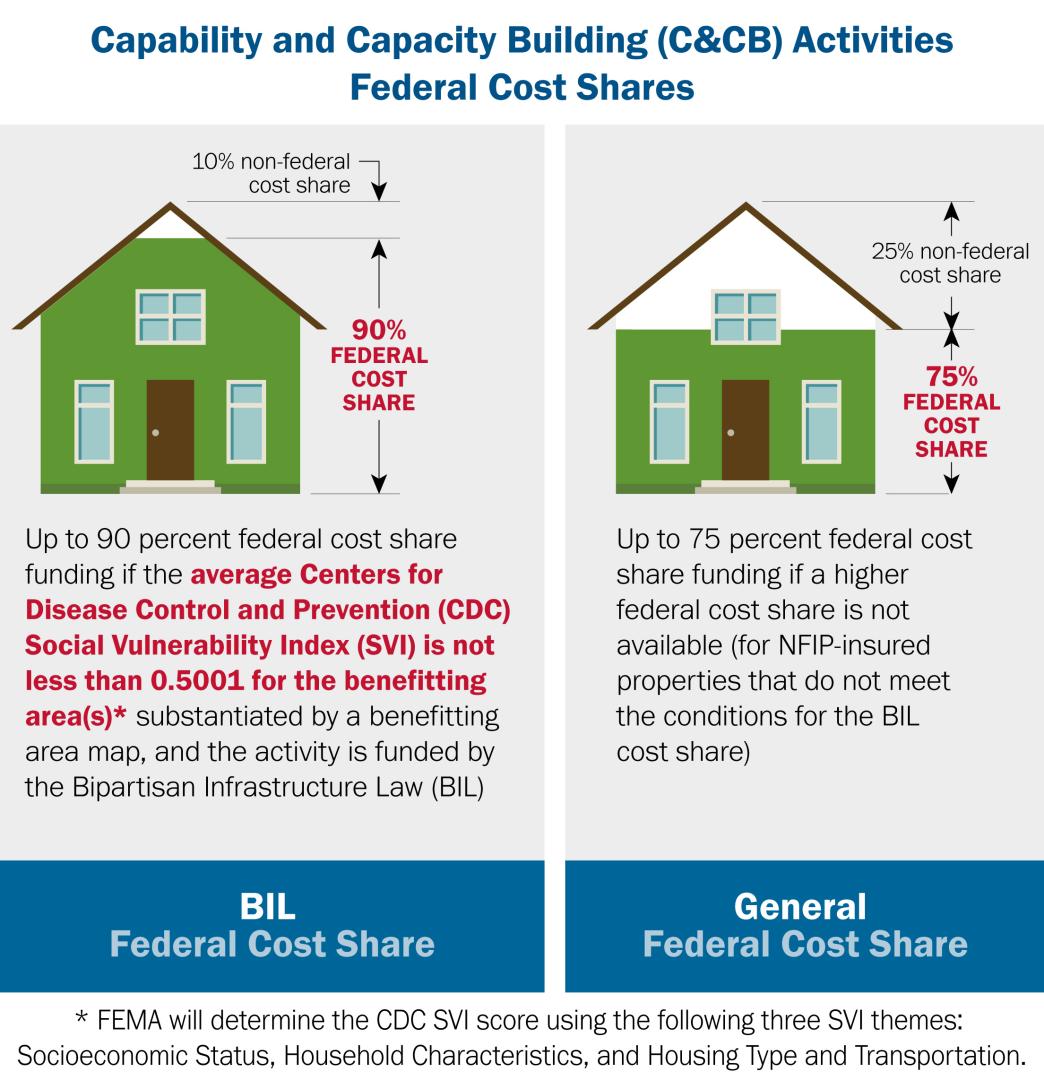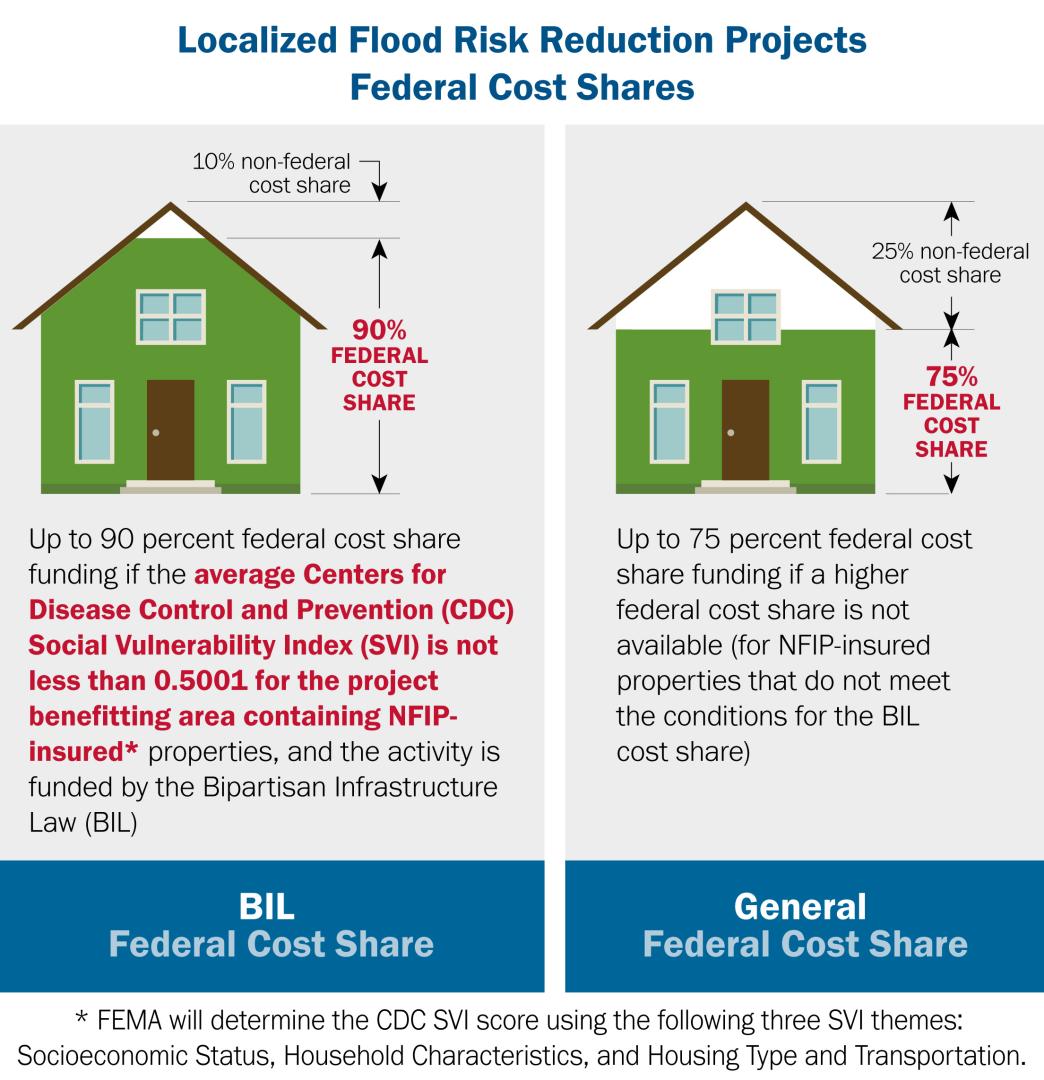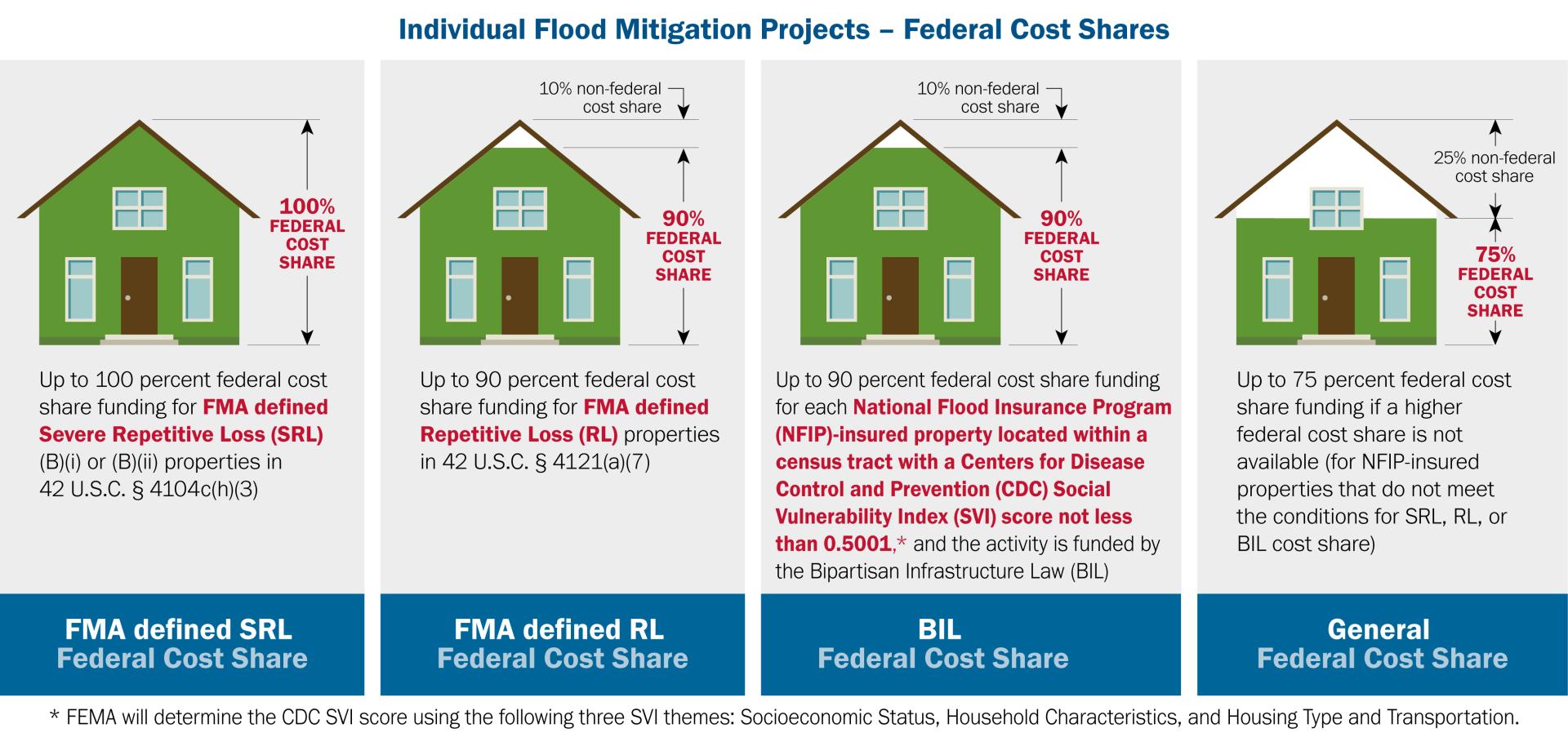Using FEMA GO to Apply
Management Costs
Cost Share or Non-Federal Match
Project Scoping
Environmental & Historic Requirements
Showing Cost-Effectiveness
To apply for the fiscal year (FY) 2023 Flood Mitigation Assistance grant program funding opportunity, please note the following application deadlines:

Application Opening: Oct 16, 2023
Application Deadline: Feb 29 2024, 3 p.m. Eastern Time
Using FEMA Grant Outcomes to Apply
Eligible applicants and subapplicants must apply for funding using the grants management system: FEMA Grant Outcomes (FEMA GO). Flood Mitigation Assistance will not accept paper applications.
Learn more about the FEMA GO system, including user guides and templates. Or directly access the FEMA GO portal.
Submitting as an Applicant or Subapplicant
Applicants may work with their FEMA region. Subapplicants may work with their respective applicant (state, federally recognized Tribal government or U.S. territory) to submit a subapplication. Subapplicants should consult with their applicant agency to confirm subapplication deadlines to the applicant if applicable.
Applicants will rank and attach subapplications. Applicants will then submit subapplications as a final, single FMA application via FEMA GO by Feb. 29, 2024, 3 p.m. Eastern Time.
New system-related issues will be addressed until Feb. 27, 2024, 3 p.m. Eastern Time. Applicants facing technical problems outside of their control must notify FEMA by this deadline.
Resource
Visit our FEMA GO page for details on navigating the new FEMA GO system and its application process.
Please note that FEMA deadlines listed refer to application deadlines for the applicants. Subapplicants should check with their applicant agency to confirm their deadlines.

Need help with your application?
For FEMA GO: Email the FEMA GO Helpdesk or call 877-585-3242.
For Hazard Mitigation Assistance-specific questions: Call the HMA Helpline at 866-222-3580.
If applicants do not know who to contact or if there are programmatic questions or concerns, please contact the FEMA Grants Information Desk by e-mail OR by phone at (800) 368-6498, Monday through Friday, 9 a.m. – 5 p.m. Eastern Time.
Federal Cost Share or Non-Federal Match
Cost share is required for all subapplications funded by the Flood Mitigation Assistance grant program. Generally, the cost share for this program is 75% federal cost share and 25% non-federal cost share. Contributions of cash, third-party in-kind services, materials, or any combination thereof, may be accepted as part of the non-federal cost share.
Cost Share Information Specific for Flood Mitigation Assistance
FEMA may contribute increased federal cost share for properties that are insured under the National Flood Insurance Program (NFIP) at the time of application and meet the definitions of Severe Repetitive Loss (SRL) or Repetitive Loss (RL).
FEMA may contribute up to 90% federal cost share (for eligible costs) for activities or projects that impact properties with NFIP insurance that are located within a census tract with a Centers for Disease Control and Prevention (CDC) Social Vulnerability Index (SVI) score of not less than 0.5001. FEMA will determine the CDC SVI score using the following three SVI themes: Socioeconomic Status, Household Characteristics, and Housing Type and Transportation.
Applicants and Subapplicants can determine their activities and projects’ CDC SVI score by calculating the three SVI themes’ averages using information on the CDC/ATSDR Social Vulnerability Index webpage.

Title 42 of the U.S. Code defines Repetitive Loss and Severe Repetitive Loss mitigation assistance. Refer to Chapter 50 – National Flood Insurance for more specific information.
Capability and Capacity-Building (C&CB) Activities
- Up to 90% federal cost share funding if the average Centers for Disease Control and Prevention (CDC) Social Vulnerability Index (SVI) score is not less than 0.5001 for the benefiting area(s) substantiated by a benefiting area map, and the activity must be funded by Bipartisan Infrastructure Law (BIL). FEMA will determine the CDC SVI score using the following three SVI themes: Socioeconomic Status, Household Characteristics, and Housing Type and Transportation; or
- Up to 75% federal cost share funding if a higher federal cost share is not available.

Localized Flood Risk Reduction Projects
- Up to 90% federal cost share funding if the average CDC SVI score is not less than 0.5001 for the project benefiting area containing NFIP-insured properties, and the activity must be funded by the BIL. FEMA will determine the CDC SVI score using the following three SVI themes: Socioeconomic Status, Household Characteristics, and Housing Type and Transportation; or
- Up to 75% federal cost share funding if a higher cost share is not available.

Individual Flood Mitigation Projects
- Up to 100% federal cost share funding for FMA defined Severe Repetitive Loss (SRL) (B)(i) or (B)(ii) properties in 42 U.S.C. § 4104c(h)(3); or
- Up to 90% federal cost share funding for FMA defined Repetitive Loss (RL) properties in 42 U.S.C. § 4121(a)(7); or
- Up to 90% federal cost share funding for each NFIP-insured property located within a census tract with a CDC SVI score is not less than 0.5001, and the activity must be funded by the Bipartisan Infrastructure Law. FEMA will determine the CDC SVI score using the following three SVI themes: Socioeconomic Status, Household Characteristics, and Housing Type and Transportation; or
- Up to 75% federal cost share funding if a higher federal cost share is not available.

Severe Repetitive Loss Federal Cost Share Information
FEMA may contribute 100% federal cost share. The Biggert-Waters Flood Insurance Reform Act of 2012 updated the definition of a Severe Repetitive Loss (SRL) property. This includes:
(b) A current National Flood Insurance Program policy is in effect for both building and contents coverage. The property must have incurred flood-related damage with the following criteria:
- Four or more separate claims payments (includes building and contents) have been made under flood insurance coverage. The amount of each such claim must exceed $5,000, and the cumulative amount of such claims payments must exceed $20,000; or
- At least two separate claims payments (includes only building coverage) with the cumulative amount of such claims exceeding the market value of the insured structure.
Repetitive Loss Federal Cost Share Information
FEMA may contribute up to 90% federal cost share. A Repetitive Loss (RL) property is defined by a flood insurance policy issued for the National Flood Insurance Program . The definition includes the following two items:
- Incurred flood-related damage on two occasions, in which the cost of the repair, on the average, was at least 25% of the market value of the structure at the time of each such flood event.
- At the time of the second incidence of flood-related damage, the contract for flood insurance contains Increased Cost of Compliance (ICC) coverage.
Management Costs
Management costs are any indirect costs, direct administrative costs, and other administrative expenses that are reasonably incurred in administering an award or subaward.
Applicants are eligible to receive management costs consisting of a maximum of 10% of the planning and project activities awarded to the state, each fiscal year under FMA. These costs must be included in the application to FEMA.
A federally recognized tribal government applying directly to FEMA is eligible for management costs consisting of a maximum of 10% of grants awarded for planning and project activities under the FMA program. Subapplicants may include a maximum of 5% of the total funds requested for their subapplication for management costs to support the implementation of Capability and Capacity Building Activities, Localized Flood Risk Reduction Projects, or Individual Flood Mitigation Projects. These costs must be included in the subapplication to the Applicant.
Eligible management cost activities may include:
- Solicitation, review and processing of subapplications and subawards.
- Subapplication development and technical assistance for feasibility and effectiveness and BCA.
- Geocoding mitigation projects that FEMA has identified for further review.
- Delivery of technical assistance (e.g., plan reviews, planning workshops, training) to support the execution of mitigation activities.
- Managing awards (e.g., quarterly reporting, closeout).
- Technical monitoring (e.g., site visits, technical meetings).
- Purchase of equipment; per diem and travel expenses; and professional development that is directly related to the execution of HMA programs.
- Staff salary costs directly related to performing the activities listed above.
Notice of Funding Opportunity Priorities
Capability and Capacity Building (C&CB) Activities
Capability and Capacity Building Activities enhance the knowledge, skills, expertise, etc., of the current workforce to expand or improve the administration of Flood Mitigation Assistance. These activities may be used to develop future Localized Flood Risk Reduction Projects and/or Individual Flood Mitigation Projects that will subsequently reduce flood National Flood Insurance Program (NFIP) claims. The funding order for Capability and Capacity Building Activities is as follows:
- Mitigation Plans for the development or update of a Mitigation Plan(s). Mitigation Plan subapplications will be evaluated to ensure that the result will provide benefits to the NFIP.
- Technical Assistance by States to Communities must have received an FY 2022 FMA award of at least $1 million federal cost share. Technical Assistance by States to Communities funding is provided to maintain a viable FMA program over time.
- Project Scoping can be used to obtain data and to prioritize, select, and develop future Localized Flood Risk Reduction Projects and/or Individual Flood Mitigation Projects based on current FEMA-approved mitigation plans. Project Scoping subapplications will be evaluated to ensure that the result will lead to an eligible project subapplication that will provide benefits to the NFIP.
- Additional Capability and Capacity Building Activities including activities in the following sub-categories: Partnership Development to Conduct Eligible Mitigation Activities, Enhancing Local Floodplain Management, Severe Repetitive Loss /Repetitive Loss Strategy Development, and other eligible Capability and Capacity Building Activities.
Localized Flood Risk Reduction Projects (previously Community Flood Mitigation Projects)
Localized Flood Risk Reduction Projects address localized flood risk for the purpose of reducing National Flood Insurance Program (NFIP) flood claim payment.
This document will provide details on project requirements and scoring criteria: Flood Mitigation Assistance – Localized Flood Risk Reduction Projects Program Support Material.
To learn more, refer to Localized Flood Risk Reduction Projects in the Hazard Mitigation Assistance Program and Policy Guide.
Individual Flood Mitigation Projects
Individual Flood Mitigation Projects are those that reduce the risk of flooding to individual NFIP-insured structures and give priority to properties meeting Severe Repetitive Loss (SRL) and Repetitive Loss (RL) definitions. These project types include acquisition, acquisition relocation, relocation, elevation, mitigation reconstruction, and dry floodproofing of historic or commercial structures.
Properties in a project subapplication for Flood mitigation Assistance funding must be NFIP-insured at the time of the application opening date. The owner must have flood insurance during the mitigation activity and for the life of the structure. This document will provide details on project requirements and scoring criteria: Flood Mitigation Assistance – Individual Flood Mitigation Projects Program Support Material.
To learn more on individual flood mitigation project types, refer to
- Acquisition Technical Review Job Aid
- Elevation Technical Review Job Aid
- Elevation Technical Supplement-EHP
Environmental Planning and Historic Preservation Requirements
For Flood Mitigation Assistance funding, a project must comply with all applicable Environmental Historic Preservation laws, executive orders and regulations to assess the impacts of a proposed project on physical, cultural, biological and social resources. All project subapplications must undergo an EHP review prior to award.
The National Environmental Policy Act (NEPA) requires FEMA and other federal agencies to assess the environmental impacts of alternatives to a proposed project. FEMA must also ensure a proposed project meets the requirements of other federal laws and EOs. These include the Clean Water Act (CWA), Endangered Species Act (ESA), National Historic Preservation Act (NHPA), Executive Order 11988 Floodplain Management, and Executive Order 11990 Protection of Wetlands.
Applicants should consider environmental impacts early in the Project Scoping and development stages. This will help reduce impacts and avoid delays and other costs at later stages. Early environmental planning, including possible conservation and mitigation measures that the project can take to reduce harms, may also speed up the review process.

For questions about National Environmental Protection Act or Environmental Historic Preservation requirements, email the EHP Helpline or call 866-222-3580.
Some project types do not require an EHP review if they are listed as a Categorical Exclusion; they would not lead to a major environmental impact.
When scoping a project, applicants and subapplicants should complete the EHP Checklist. This includes understanding where impacts could be reduced. FEMA refers to thinking about EHP impacts as early as possible as “EHP frontloading.” Find guidance on EHP frontloading during application development.
EHP Considerations for Localized Flood Risk Reduction Projects
Localized Flood Risk Reduction Projects are meant to lessen the frequency or depth of flooding. These projects involve activities such as installing or modifying culverts and other stormwater management facilities; building or modifying retention and detention basins; applying nature-based solutions; and building or modifying floodwalls, dams and weirs. Localized Flood Risk Reduction Projects may affect floodplain resources. They may also change flood elevations or extend both upstream and downstream from the project.
The methods used to construct a Localized Flood Risk Reduction Project may lead to erosion and sedimentation. They can also affect species or human communities. Ground disturbance could affect archaeological resources, soils or utilities. Major flood control construction projects may require more in-depth NEPA analysis via an Environmental Assessment or Environmental Impact Statement.
Nature-Based Solutions
Nature-based solutions are actions to protect, sustainably manage, or restore natural or modified ecosystems to address societal challenges, simultaneously providing benefits for people and the environment. FEMA recognizes that strategies for nature-based solutions are diverse; one size does not fit all. As such, examples of nature-based solutions may include wetland restoration and protection; greenways; stormwater parks; floodplain restoration; rain gardens; green roofs; permeable pavement; coastal wetlands; and living shorelines. Refer to these resources for additional information on nature-based solutions: FEMA’s Nature Based Solutions webpage and this Nature Based Solutions Roadmap published by the White House.
Localized Flood Risk Reduction Projects subapplication are assessed for incorporation of nature-based solutions with a final priority scoring criteria. To receive the point allotment for this criterion, the subapplication must describe how the project entails one or more nature-based solutions.
Resources
Hazard Mitigation Assistance Environmental Planning and Historic Preservation FEMA Supplement - Flood Risk Review
To learn more check out FEMA’s Building Community Resilience with Nature-Based Solutions: A Guide for Local Communities.
Showing Cost-Effectiveness
Applicants and subapplicants applying for hazard mitigation projects (Localized Flood Risk Reduction Projects or Individual Flood Mitigation Projects) must provide a Benefit-Cost Analysis (BCA) or other documentation that validates cost-effectiveness. Benefit-Cost Analysis (BCA) determines the future risk reduction benefits of a hazard mitigation project. It then compares those benefits to its costs. The result is a benefit-cost ratio. A project is deemed cost-effective when the benefit-cost ratio is at least 1.0.
FEMA’s Benefit Cost Toolkit is available online. A non-FEMA BCA methodology may only be used if pre-approved by FEMA in writing.
Structure acquisitions and elevations located in the Special Flood Hazard Area (SFHA) may use pre-calculated benefits to determine cost effectiveness. Acquisitions of Repetitive Loss (RL) and Severe Repetitive Loss (SRL) properties regardless of their location in the SFHA may also use pre-calculated benefits to determine cost effectiveness. Learn more about pre-calculated benefits.

Subapplications for Capability and Capacity Building Activities and Management Costs do not need a benefit cost analysis. To learn more about Beneift Cost Analysis requirements, email the BCA Helpdesk or call toll-free at 1 (855) 540-6744.


